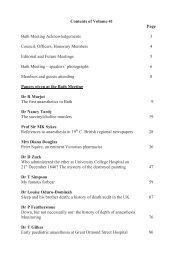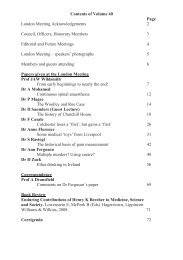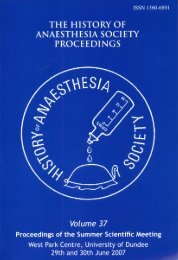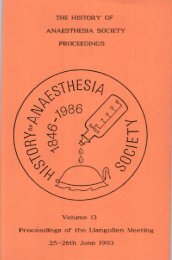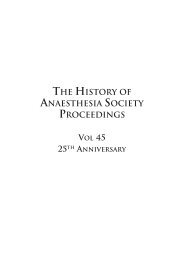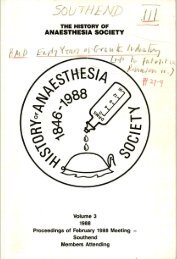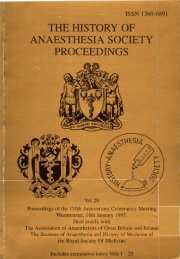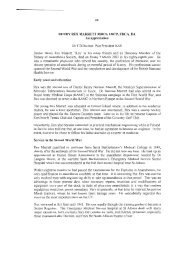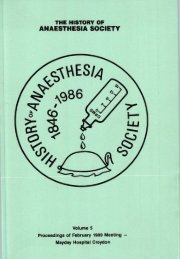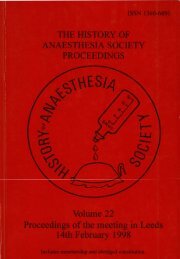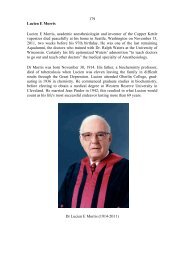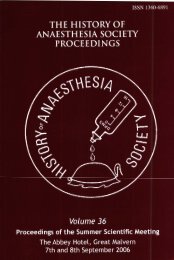Volume 7 - History of Anaesthesia Society
Volume 7 - History of Anaesthesia Society
Volume 7 - History of Anaesthesia Society
Create successful ePaper yourself
Turn your PDF publications into a flip-book with our unique Google optimized e-Paper software.
This memorial, which it appears was not very solid, lasted for only four<br />
yews. In April 1941, it was severely damaged by an enemy bomb which<br />
exploded nearby and it virtually disintegrated. In July 1949, Dr George<br />
Edwards, another <strong>of</strong> the distinguished anaesthetists whom we 10s t last<br />
year, reported the fact to the Council <strong>of</strong> the Association <strong>of</strong><br />
4naesthetists. An estimate was obtained by them for the cost <strong>of</strong> repair,<br />
which was expected to be at least f100. The War Damage Cmission,<br />
which had been set up to aid the reconstruction <strong>of</strong> buildings and<br />
rnonunfents damaged by enemy action, was expected to make available only<br />
110. An a eal was made in the April 1950 number <strong>of</strong> the journal<br />
'<strong>Anaesthesia</strong>" and by October <strong>of</strong> that year nearly X134 had been raised<br />
from various sources in Britain and North America. Tne Section <strong>of</strong><br />
Anaesthetics <strong>of</strong> the London Academy <strong>of</strong> Medicine in Canada contribute<br />
C8.10.0. (L 8.50) and the Edinburgh Association <strong>of</strong> Anaesthetists £5. !l<br />
'he final cost <strong>of</strong> restoration was nearly f155.<br />
In July 1951, the work was put in hand and was completed in time Eor the<br />
26th 4nnual Congress Anaesthetists which was held in London in<br />
September <strong>of</strong> that yea:' George Edwardr was asked to organise the<br />
unveiling ceremony <strong>of</strong> the new memorial and this was performed by Miss<br />
Una Snow, John Snow's great-niece, on Sepi~ber 6th, in the presence <strong>of</strong><br />
some <strong>of</strong> the participants at the Congress. In 1958, on the occasion<br />
<strong>of</strong> the centenary <strong>of</strong> Snow's death, wreaths were laid on the grave by the<br />
President <strong>of</strong> the Association <strong>of</strong> Anaesthetists, Pr<strong>of</strong>essor Cecil Gray, the<br />
Dean <strong>of</strong> the Faculty oE Anaesthetists, Dr Frankis Evans, and the<br />
Presidents <strong>of</strong> the Section <strong>of</strong> Anaesthetics <strong>of</strong> the Royal <strong>Society</strong> <strong>of</strong><br />
Medicinft Dr B.L.S.Murtagh, and <strong>of</strong> the Section <strong>of</strong> Epidemiology, Dr Ian<br />
Taylor. The stone is in excellent condition, although it is rather<br />
stained at its base and the inscription is becoming difficult to read.<br />
I have taken the liberty <strong>of</strong> recounting this short history <strong>of</strong> John Snow's<br />
grave, because there may be some who have not seen it and who may be<br />
uncertain where to find it. (see map) The entrance to the cemetery is<br />
in Old Brompton Road, on the 30 and 74 bus routes, and next to West<br />
Brompton Station on the District Line. More trains go to Earls Court<br />
Station, which is only a few minutes' walk away. The cemetery, which is<br />
now a Royal Park, is open to the public during the hours <strong>of</strong> daylight.<br />
It is a wonderful example <strong>of</strong> Victorian necropolis. I first knew <strong>of</strong> it<br />
over Eorty years ago when I lived in Earls Court. One <strong>of</strong> my small soys<br />
was always keen to visit it to see what he called the 'cows with wings ,<br />
meaning the stone angels on some <strong>of</strong> the more ornate tombs. As soon as<br />
one entzrs the cemetery, one can see John Snow's tomb at the start <strong>of</strong><br />
the first path on the left, on the right hand side. Joseph Clover is<br />
also buried there, but his grave is more difficult to find. If one<br />
carries on down the main avenue to the sixth path on the left and goes<br />
along it and round the extension oE the first building, one will find it<br />
behind another grave, about six paces beyond the first cross-path. It is<br />
in good condition, but very overgrown.<br />
I hope that these memorials <strong>of</strong> two great men are kept in good state and<br />
are not allowed to deteriorate.



